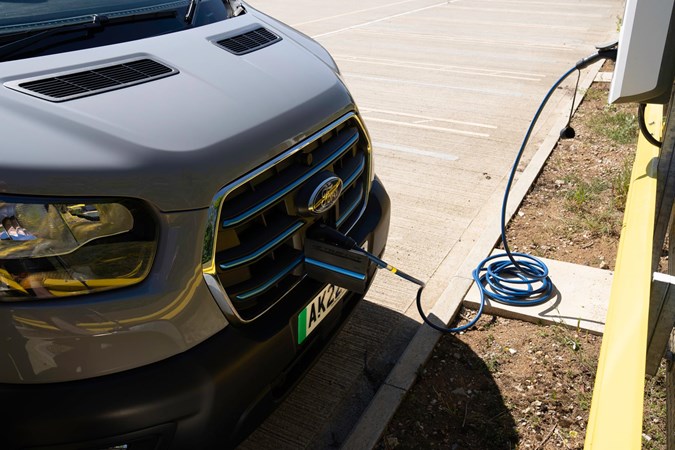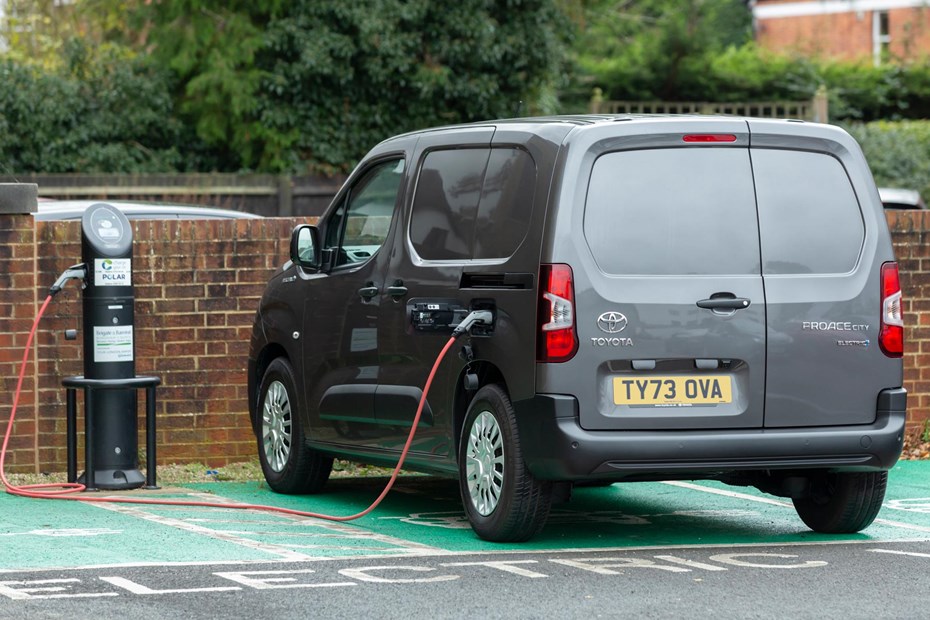The Government has laid out exactly how many zero-emission or electric vans manufacturers must sell in the UK each year up until the ban on the sale of new petrol and diesel vehicles in 2035.
Despite delaying the overall ban on pure petrol and diesel vehicles from 2030 to 2035, the government has stuck to its proposed plans to bring in a target for each year from 2024. Electric vans will have to account for 10% of manufacturers’ sales in 2024, with this figure rising each year. The overall market share for battery electric vehicles in 2023 to date is currently at 5.4%, so brands have some way to go.
Those that don’t manage to sell a sufficiently high number of electric vehicles will have to pay a penalty for every vehicle that misses the target. However, the amount that van makers will have to pay has been cut, for the first year at least. Those that don’t make the target in 2024 will have to pay £9,000 for every van over the barrier, but this then rises to the originally proposed £18,000 in 2025.

A Zero Emission Vehicle is defined as one that produces 0g/km of CO2 and has a minimum range of 100 miles. They must also provide a warranty of eight years/100,000 miles for the battery, with a minimum remaining capacity of 65% required at the end of that period.
Annual targets
The Government recognises that demand for electric vans is not as strong as was originally forecast, but it is sticking by its originally proposed 10% target for 2024. This then rises to 16% in 2025 and 24% in 2026.
The full timeline is as follows:
| Year | 2024 | 2025 | 2026 | 2027 | 2028 | 2029 | 2030 | 2031 | 2032 | 2033 | 2034 | 2035 |
| Target | 10% | 16% | 24% | 34% | 46% | 58% | 70% | 76%* | 82%* | 88%* | 94%* | 100%* |
The only caveat to this is that the targets from 2031 are yet to be set into law, with the final consultation document saying that this will happen later in the decade. Given that the target for 2030 is at 70%, it would take something notable to change this from the current figures.
Exceptions from the targets
The targets are not universal, however, as small-scale manufacturers will be able to apply for a derogation – effectively making them exempt from the proposals. Those registering more than 999 cars or vans per year, but fewer than 2,500, will be able to apply for this derogation.
This is less likely to be relevant in the world of vans, though, as the only small-scale manufacturers are newer brands such as Morris Commercial, which is concentrating on electric vehicles.
The other exception is Special Purpose Vehicles (SPVs). Those vehicles that are ‘critical to… mobility needs’ will be exempt – think private ambulances and Wheelchair Accessible Vehicles (WAVs). Not all SPVs will be exempt, though – motor homes will not, nor are hearses.
Earned credit
There are a few other ways that manufacturers will be able to game the system. Vehicles that are registered to a vehicle sharing club – the likes of Zipcar etc – will get them 1.5 credits rather than the usual one. They have to remain on the sharing club fleet for 18 months, though, so they can’t be registered and resold swiftly. The exception to this is if the van is written off in the first 18 months of its life – if that happens then the manufacturer won’t lose its credits for that vehicle.
Manufacturers will also be able to carry over credits if they sell more than their target in a particular year. If they sell 500 more EVs than they have to in one year, then their target next year is reduced by the same figure.
Wheelchair Accessible Vehicles will also gain 1.5 credits, even though they are exempt from the targets.
Brands will also be able to share their credits with one another, or become part of a ‘pool’. So if Peugeot sells 10 more than it needs to and Citroen 10 fewer, then the two will be able to share.
Reaction
Manufacturers and trade bodies were involved in honing the targets, and they largely welcome the fact that they have been listened to.
SMMT chief executive, Mike Hawes, said: ‘With less than 100 days to go, manufacturers finally have clarity on what they are required to sell next year and up to 2030. The industry is investing billions in decarbonisation and recognises the importance of this mechanism as the single most important measure to deliver net zero. Delivering the mandate will challenge the industry, despite the flexibilities now included to support pragmatic, equitable delivery given this diverse sector.’
Ford also cautiously welcomed the announcement, with Ford UK chair Lisa Brankin saying it was good to see some of its ideas reflected.
Not all are in favour of the announcement by any stretch, though, with Auto Trader commercial director Ian Plummer saying that it sent mixed messages.
‘Combined with the delay to the ban on new diesel and petrol sales until 2035, the Government is sending mixed messages in a crucial policy area. The key now will be to support consumers in making the switch. That won’t be easy given the current barriers of high upfront cost and charging infrastructure – despite the significant savings to be made from running an EV.
‘When it comes to the vans mandate, the softening of the annual targets is a pragmatic step that will provide much needed breathing room for certain manufacturers. It also gives the fleet and business sectors – the biggest van buyers – more choice while electric van technology catches up with business requirements, and electric vans become more affordable for small businesses.’
Just so you know, we may receive a commission or other compensation from the links on this website - read why you should trust us.






